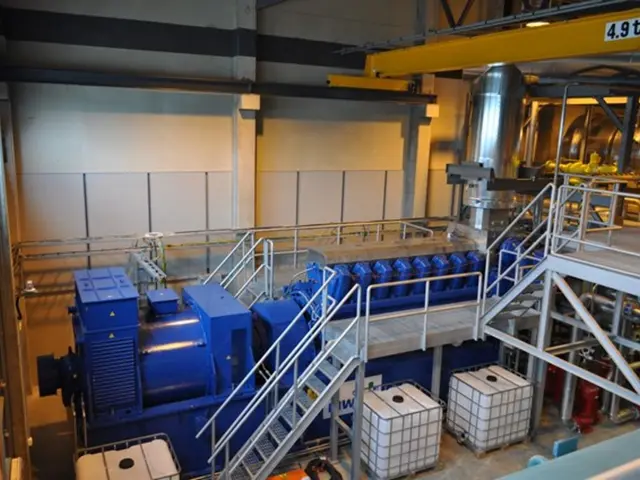Tenants' Sustainability Preferences in Property Rentals: Fulfilling Market Demands by Greycoat and Nick Millican
Rewritten Article:
London's commercial real estate scene is bracing for an impending crisis: by 2030, the demand for environmentally friendly offices outweighs the supply by a staggering 35%. This hasn't gone unnoticed, with over 7,600 companies now pledged to the Science Based Targets initiative (SBTi). The surge in commitments, mostly in the last two years, is no fluke—it's a game-changing industry transformation that Nick Millican, CEO of Greycoat Real Estate, sees as a market tsunami needing strategic navigation.
"Green ratings were once a minor concern for tenants," Millican shares, who's leading Greycoat at the vanguard of sustainable real estate development in London. The shift is more than just trendy preferences; it's a regulatory, cultural, and economic blend that's redefining corporate office spaces.
Market Forces Fueling the Green Rush
It's not merely external pressure propelling businesses toward eco-friendly offices. Sustainability has become an essential business strategy. With offices embodying tangible expressions of a company's green ambitions, firms seek out energy-efficient buildings that align with their environmental goals.
Regulations are tightening the noose. Governments are heightening carbon disclosure requirements, and new energy efficiency standards are setting the bar higher for compliance. In London, building rules are becoming stricter, making it tough for older, energy-inefficient buildings to survive. Real estate is now at the forefront of regulatory compliance, compelling companies to prioritize green buildings that align with current and future carbon reduction laws.
"There's a greater need to invest in green buildings now than ever before," Millican points out, "because of the environmental regulations in London changing."
A generational shift is also happening. Eco-conscious young workers are no longer satisfied with corporations merely talking about sustainability. They want action. This new wave of employees is reshaping how companies view their offices, prioritizing sustainability as a critical factor for attracting and retaining talent.
The financial case for green real estate is equally strong. Industry research shows that sustainable buildings in London command an average premium of 11.6% in rents compared to traditional properties. This premium isn't just a tenant preference—it's a recognition that energy-efficient, low-carbon buildings offer long-term financial benefits by lowering operational costs and aligning with corporate sustainability aspirations.
Greycoat's Green Growth Strategy
Under Millican's guidance, Greycoat is reenvisioning sustainability within its real estate portfolio. The company is focusing on transforming existing buildings for a low-carbon future, recognizing that older properties contribute significantly to urban carbon emissions. Greycoat's strategy involves substantial investments in retrofitting these properties to meet modern energy standards.
"Demolishing buildings and rebuilding new ones isn't always practical or eco-friendly," Millican emphasizes. "So the more we can conserve, the better the carbon footprint of what we're doing."
This Conservation-centric approach isn't just environmentally responsible—it's smart business. Millican has observed a clear split in the commercial real estate market: "It's becoming a two-tier market. There are properties that are desirable, energy-efficient, and modern-rents even increase for them. Then there are properties that aren't up to the mark and probably need to be repurposed."
Greycoat's commitment to retrofitting older buildings places the company firmly in the sustainable, premium tier.
The DIALS Project: Leading the Green Revolution
Greycoat's commitment to sustainability shines in projects like the DIALS, a 6-story office building in the City of London. Acquired in partnership with Goldman Sachs Asset Management in December 2023, this ambitious project aims to transform the building's entire infrastructure to meet the highest environmental sustainability standards.
"Our vision for DIALS transcends acquisition," Millican explains. "We're embarking on a mission to transform this 140,000 sq ft space into a trailblazer in green innovation."
Greycoat's Director Dan Higginson emphasizes the potential impact of the project: "Because it's a very ambitious initiative for us, it will be exciting to see how much refurbishment projects can genuinely deliver on environmental standards. It will prove that you don't need to demolish a building to achieve a certain performance level-you can rejuvenate an existing one through thoughtful interventions."
The DIALS makeover will include comprehensive renovations that retain the building's structural and aesthetic integrity while integrating cutting-edge sustainable technologies like upgraded windows and building insulation to improve thermal efficiency.
Millican has ambitious goals for the project: "Our aim is to achieve BREEAM Outstanding, EPC A, and WELL Platinum ratings for DIALS. These certifications aren't mere badges-they symbolize our determination to pioneer green building practices that prioritize both environmental health and occupant wellness."
Such a focus on certifications and performance standards resonates with tenant expectations. As companies increasingly consider environmental performance when leasing office spaces, Greycoat's commitment to top-tier sustainability ratings positions DIALS as an attractive option for forward-thinking organizations.
Investing in Green for Long-term Success
For Greycoat, sustainability isn't only about catering to present-day demands—it's about safeguarding their portfolio's future. "The environmental performance of a property is increasingly crucial to occupiers, lenders, investors, and eventual buyers," a Greycoat development and leasing director notes.
Millican is confident that the industry as a whole will follow Greycoat's lead and prioritize sustainability: "I believe we'll see growing emphasis on conservation and renovation rather than destruction and rebuilding."
As the supply of eco-friendly office spaces lags behind demand, firms that prepare themselves ahead of the curve, like Greycoat, are setting an example for the industry to follow. By focusing on retrofitting, renewable integration, and sustainable certifications, Greycoat demonstrates one path toward aligning with tenant expectations and maintaining strong business performance.
For Nick Millican and Greycoat, the green wave isn't just a hurdle to navigate—it's an opportunity to spearhead the industry's transformation. By understanding what tenants need and value in their workspaces and delivering buildings that combine environmental responsibility with operational excellence, they're helping sculpt a greener, more resilient urban landscape for London's tomorrow.
Enrichment Data:
The key market forces driving the demand for sustainable real estate in London's commercial market are multifaceted and reflect a convergence of regulatory pressures, cultural expectations, and business imperatives. Here are some of the primary factors at play:
- Regulatory Pressure: Increasingly strict environmental regulations are forcing companies to adopt sustainable practices. In London, upcoming restrictions and targets for carbon emissions are pushing businesses to seek green office spaces[5].
- Business Strategy and Reputation: Sustainability has become essential to companies' business strategies and reputations. For companies committing to the Science Based Targets initiative (SBTi), green real estate is a crucial way to demonstrate their environmental commitment[5].
- Cultural Expectations: The cultural shift towards sustainability is significant, with tenants increasingly seeking responsible buildings. This transition isn't just a preference but an essential move for companies aiming to align their operations with societal norms[5].
- Economic Incentives: Sustainable buildings in London command a "green premium" of 11.6% in rents compared to traditional properties, providing an economic incentive for investors and developers to concentrate on eco-friendly real estate[5].
- Supply and Demand Imbalance: By 2030, demand for low-carbon office space will exceed supply by 35%, creating a pressing requirement for sustainable developments to keep up with future demand[5].
- Technological Advancements: The integration of technologies like solar power is becoming prevalent in commercial real estate, helping reduce operational costs and support net-zero initiatives[2].
- The demand for environmentally friendly offices in London's commercial real estate scene will surpass supply by 35% by 2030.
- Nick Millican, CEO of Greycoat Real Estate, sees the surge in companies pledged to the Science Based Targets initiative (SBTi) as a market tsunami requiring strategic navigation.
- Sustainability has become an essential business strategy, with firms seeking out energy-efficient buildings that align with their environmental goals.
- Regulations are tightening, making it tough for older, energy-inefficient buildings to survive in London due to stricter building rules and carbon disclosure requirements.
- Companies in London now prioritize green buildings to comply with current and future carbon reduction laws, as real estate is at the forefront of regulatory compliance.
- Eco-conscious young workers are reshaping the corporate perspective on offices, prioritizing sustainability as a critical factor for attracting and retaining talent.
- Industry research shows that sustainable buildings in London command an average premium of 11.6% in rents compared to traditional properties.
- Greycoat Real Estate is focusing on transforming existing buildings for a low-carbon future by making substantial investments in retrofitting older properties.
- The DIALS project, a 6-story office building in London, aims to transform its entire infrastructure to meet the highest environmental sustainability standards.
- Greycoat’s goal is to achieve BREEAM Outstanding, EPC A, and WELL Platinum ratings for the DIALS project, symbolizing their determination to pioneer green building practices.
- The green wave in the commercial real estate market provides an opportunity for firms like Greycoat to lead the industry's transformation by delivering buildings that balance environmental responsibility with operational excellence.








